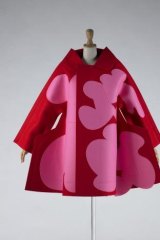Coolest Most Avante Garde Artistic Japanese Fashion Designers
- Culture
This was published 7 years agone
Mode from the edge: how Japanese designers changed the style we dress
By Lindy Percival
You might not have heard of Rei Kawakubo, but inside your wardrobe, her presence tin can be felt. Every bit one of a ring of advanced Japanese designers who rocked the fashion world in the early 1980s, she helped to usurp western notions of beauty and forever change the fashion we wearing apparel.
When Kawakubo and Yohji Yamamoto first infiltrated Paris catwalks, the west was still brimful with figure-hugging frocks, vertiginous heels and Dynasty-style backlog. Imagine the reaction, and then, when models emerged in baggy, monochrome, multi-layered ensembles, complete with rips, asymmetrical hemlines and apartment, mesomorphic shoes. Fashion writers reportedly wept. Others fled. The term "apocalyptic habiliment" was built-in.

Comme des Garçons (Rei Kawakubo) / Autumn/Wintertime 2012-xiii / Drove: Kyoto Costume Found Credit: Masayuki Hayashi
Today, watching footage from those early shows inside Brisbane'southward Gallery of Modernistic Fine art (GOMA), it'due south difficult to fathom what all the fuss was most. The dress, like the models themselves, seem the prototype of timeless chic – edgy, yep, but hardly apocalyptic. But in the context of all that had come up before, the shift was profound. As the Washington Post declared: "Japanese designers have fired the opening shots in the battle for fashion pre-eminence." Showy excess was being nudged bated past an inscrutable eastern artful and western manner would never be the aforementioned once more.
At present, these revolutionary garments can be seen upwardly close in GOMA'due south summertime exhibition, Future Beauty: 30 Years of Japanese Fashion. Much more than merely a high-end frock prove, the exhibition offers an intriguing take on Japanese philosophy, examining how the principles of "wabi sabi" and "ma" have been realised in textile. Wabi sabi, broadly defined equally imperfection, is translated into rips, warped and exposed seams and asymmetrical lines. Ma, a contemplation of the space between trunk and fabric that harks dorsum to the kimono's rectangular structure, is realised in the transformation from flat, folded object to the worn, three-dimensional form.

Akiko Fukai, Director and Principal Curator, The Kyoto Costume Institute. Credit:Kazuo Fukunaga
The exhibition of more than 100 items from the Kyoto Costume Establish (KCI) is arranged according to 4 fundamental planks of Japanese design: In Praise of Shadows; Flatness; Tradition and Innovation; and Cool Nippon. The get-go section, named later a 1933 essay by Japanese novelist Junichiro Tanizaki, opens with a quote that illuminates the designers' monochrome focus. "If light is scarce then light is scarce; we will immerse ourselves in the darkness and in that location discover its own detail beauty."
Hither, in a long rectangular infinite lined on either side with plastic, mannequins stand in single file, draped in black or white garments that envelop the body in multiple folds, or hang, loose, ragged and full of holes. A black jumper designed by Kawakubo for her Comme des Garcons label seems to plummet effectually the torso, its knitted folds overlapping to create tones and shadows within its one-note palette.
Exhibition curator and KCI managing director Akiko Fukai selects this equally a typical instance of the aesthetic that caused such a stir in Paris.
"These were pieces that fabricated a very big impression in the w," she says through an interpreter. "At the fourth dimension, most of the article of clothing, specially by Yves Saint Laurent, would be coloured. But [the Japanese designers] never did the colours ... [and] at that place is no form. Very big ideas. It was not the aesthetic of the west. They didn't follow the lines of the trunk, so everyone realised that it represented a different form of femininity – a new beauty.
"The reason I came up with the title Time to come Beauty is considering I believe Japanese designers take led western blueprint into the 21st century with a new artful. I practice believe that what these designers did in the 1980s has continued to affect young people today."
She points to Yamamoto's edgy, shredded garments – "clothes that appear a bit messy" – as examples of the eternally challenging, anti-authoritarian and imperfect aesthetic favoured by youth. Evoking this spirit of rebellion, Yamamoto once said: "I remember perfection is ugly ... A gratis man does not desire such things."
Such philosophical considerations are so central in Japanese manner that writer and scholar Bradley Quinn once declared: "these are apparel fabricated to be worn past the mind too every bit the body."
Indeed, the folded forms used to illustrate the notion of Flatness seem to defy whatever western notion of wearability. 1 Kawakubo design resembles an oversized calligraphic symbol when folded but morphs into an elegantly draped clothes that drips from the shoulders. Nearby, Hiroaki Ohya's The Wizard of Jeanz, an boggling series of volume-similar constructions now collected by museums around the world, open, origami-like, into an elaborate red honeycomb class that wraps the body in polyester armour. And from the sculptural main Issey Miyake, flat and intricately folded garments blossom into bold geometric artworks that modify shape as the wearer moves.
"In Japanese design," says Fukai, "rather than creating a costume that is course-fitting, they actually lay it out flat on the ground to create the blueprint and and so put it on the body. This is a very intricate procedure."
Amid these intricately synthetic garments is Fukai's favourite, a 2012/13 Comme des Garcons jacket whose cherry-red groundwork and large pinkish flowers evoke the exuberance of pop art. From the neckline, the sleeves slope down in a directly line that seems to make no allowances for the shoulder, while the sides jut out from the hip at a precipitous 45-degree bending.
"This one I like very much," says Fukai. "It's very conceptual, like modern art, but at the same fourth dimension information technology'southward very comfortable to wearable. Anybody said 'wonderful' when I put it on."
The testify's local curator, Tarun Nagesh, GOMA's associate curator of Asian Art, agrees with the suggestion that these clothes could just take come from Nihon.
"The collections that emerged in the 1980s were really coming from a very Japanese artful and approach. In Praise of Shadows, the text, is near all those artful ideas – the texture and the light and the deconstruction and the imperfect that are such unique Japanese qualities that they admire."
An obsession with packaging is too evident in the mode younger designers such as Junya Watanabe and Jun Takahashi cull to wrap the torso.
"Presenting something in Japanese culture is very important," says Nagesh. "There'due south a specific cloth that you tie in a specific way if yous're giving someone a souvenir. The cloth may be an artwork in itself – it's all virtually the presentation and the unwrapping. And of course package blueprint is such a big thing in Japan – it's related to origami, but information technology'southward not always but about that."
In their often playful explorations of body "packaging", Japanese designers accept long collaborated with the country's innovative textiles manufacture as they push wearable forms into uncharted territory. In the late 1980s, Issey Miyake developed a technique in which cloth is cutting into oversized shapes and then heat-pressed to create permanent pleats, reducing the garment to its desired size. Today, in his label's signature Tokyo store, it's possible to watch every bit a flat, pleated piece of material is inflated from within to create a three-dimensional, wearable form.
Conveying on this spirit of innovation, Junya Watanabe, who joined Comme des Garcons as a mode graduate in 1984, has become the unofficial master of "techno couture", using revolutionary cutting techniques and state-of-the-art textiles to create clothing befitting a sci-fi motion-picture show. In the show's exploration of Tradition and Innovation, his designs traverse an array of materials, from padded polyester and wire through to waterproof acrylic resin crafted into '60s-style shifts that are modelled beneath a mock rain shower. Playing with fashion's unwritten rules and pushing material to its sculptural limits, Watanabe transforms faded denim into a fairytale evening gown, and builds voluminous garments of polyester organdie in which the body might well disappear.
From these e'er-irresolute frontiers, the exhibition makes its logical fourth step onto the streets of "Cool Japan", were young fashionistas proceed to examination the boundaries. Tourists routinely gather at Tokyo's famed Harajuka commune, where outrageously clad high school students, inspired by manga and video games, take been parading en masse since the 1990s, dressed as everything from frilly Bo Peeps and pouty Lolitas to multi-studded goths and Astro Boys. The Harajuka-style mannequins in the show's Cool Nippon section sport exaggerated curls, oversized bows and capes worthy of a manga hero.
"Cool Japan is really about the residue of the earth looking to Japan for blueprint and fine art trends and new styles," says Nagesh. "Nihon has always been a leader at soft ability, and sharing and promoting their civilization."
For Fukai, the culture that upended way 30 years ago still offers new ways of looking - at vesture and beyond.
"There are a lot of preconceptions about what people wear and often people just go, this is a garment, I wear it, only I think if you alter that, information technology can trigger changes in other ways ... And so the intention of this exhibition is for people to be more flexible, and more than complimentary in the style they perceive things."
Future Beaut
Most Viewed in Civilization
Loading
0 Response to "Coolest Most Avante Garde Artistic Japanese Fashion Designers"
Post a Comment